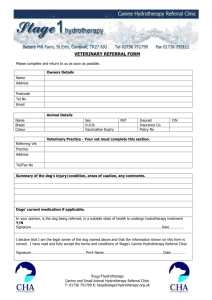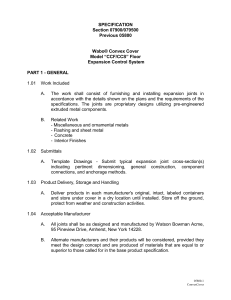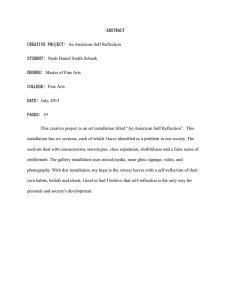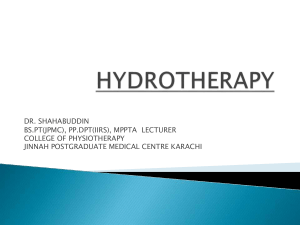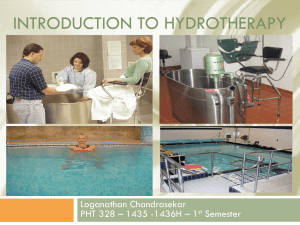11-11 SPEC WRITER NOTE: 1. Delete between // ____ // if not
advertisement
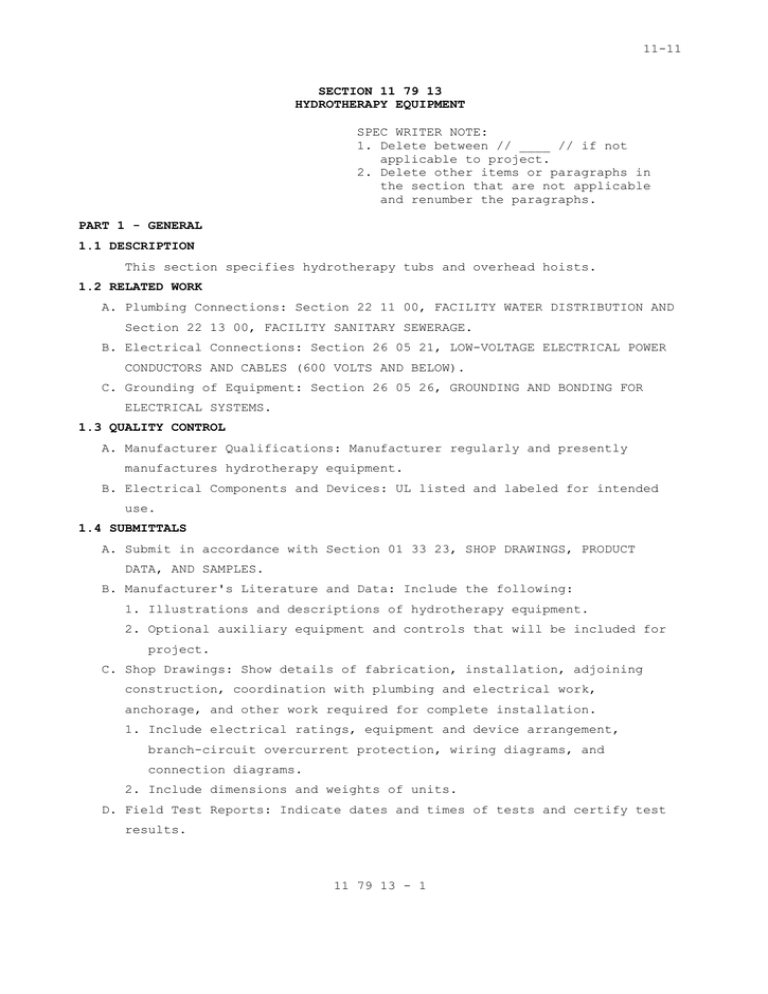
11-11 SECTION 11 79 13 HYDROTHERAPY EQUIPMENT SPEC WRITER NOTE: 1. Delete between // ____ // if not applicable to project. 2. Delete other items or paragraphs in the section that are not applicable and renumber the paragraphs. PART 1 - GENERAL 1.1 DESCRIPTION This section specifies hydrotherapy tubs and overhead hoists. 1.2 RELATED WORK A. Plumbing Connections: Section 22 11 00, FACILITY WATER DISTRIBUTION AND Section 22 13 00, FACILITY SANITARY SEWERAGE. B. Electrical Connections: Section 26 05 21, LOW-VOLTAGE ELECTRICAL POWER CONDUCTORS AND CABLES (600 VOLTS AND BELOW). C. Grounding of Equipment: Section 26 05 26, GROUNDING AND BONDING FOR ELECTRICAL SYSTEMS. 1.3 QUALITY CONTROL A. Manufacturer Qualifications: Manufacturer regularly and presently manufactures hydrotherapy equipment. B. Electrical Components and Devices: UL listed and labeled for intended use. 1.4 SUBMITTALS A. Submit in accordance with Section 01 33 23, SHOP DRAWINGS, PRODUCT DATA, AND SAMPLES. B. Manufacturer's Literature and Data: Include the following: 1. Illustrations and descriptions of hydrotherapy equipment. 2. Optional auxiliary equipment and controls that will be included for project. C. Shop Drawings: Show details of fabrication, installation, adjoining construction, coordination with plumbing and electrical work, anchorage, and other work required for complete installation. 1. Include electrical ratings, equipment and device arrangement, branch-circuit overcurrent protection, wiring diagrams, and connection diagrams. 2. Include dimensions and weights of units. D. Field Test Reports: Indicate dates and times of tests and certify test results. 11 79 13 - 1 11-11 1.5 APPLICABLE PUBLICATIONS A. The publications listed below form a part of this specification to the extent referenced. The publications are referenced in the text by the basic designation only. B. Scientific Equipment and Furniture Association (SEFA): 2-10 ................... Recommended Practices for Installation of Scientific Laboratory Furniture and Equipment 7-10 ................... Fixtures PART 2 - PRODUCTS 2.1 TANKS AND ACCESSORIES A. Tanks: 1. Manufactured of // stainless steel, not less than 2 mm (0.08 inch) thick, seamlessly welded // molded gel-coated fiberglass, double wall type //. B. Accessories: 1. Motor: 245-W (1/3-hp) high-speed motor; 3450-rpm, 110-V ac, 60-Hz, electric turbine ejector-aerator with adjustment and locking device // and built-in timer //. 2. Thermostatic Mixing Valve: // 94.6 L/min. (25 gal./min.) // 76 L/min. (20 gal./min.) // 25 L/min. (7 gal./min.) // 38 L/min. (10 gal./min.) //. 3. // Dial thermometer // Digital temperature display //. 4. Over the rim water inlet. //5. Ultraviolet automatic disinfecting system.// 6. Drain and overflow outlets. //7. Washout hose.// 8. Equip with fixtures that comply with relevant requirements in SEFA 7. 2.2 HOIST AND TROLLEY A. Manufacturer’s standard unit with water stretcher having two canvas crossbars and suspensions; and two canvas body slings. B. Capacity: 227 kg (500 lb). C. Equip with instantaneous reverse, circuit breaker, upper and lower limit switches; upper and lower safety hook; insulated lower block; chain container; 24-V moistureproof push-button control; and suspensions, clips, and hooks. 11 79 13 - 2 11-11 2.3 FABRICATION For electrically controlled components, wire and make connections within unit at factory. PART 3 - EXECUTION 3.1 INSTALLATION Install units according to manufacturer’s written instructions and relevant requirements in SEFA 2. 3.2 TESTING A. Field test installed units after water systems are pressurized for proper operation. 1. Operate hydrotherapy tubs for not less than one hour. Operate hoists through repeated full cycles for not less than one hour. During and after testing, there shall be no evidence of leaks, overheating, electrical malfunction, or other symptom of failure. 2. For units that fail testing, make adjustments and corrections to installation, or replace units, and repeat tests until units operate properly. 3.3 PROTECTING AND CLEANING A. Protect equipment from dirt, water, and chemical or mechanical injury during the remainder of the construction period. B. At the completion of work, clean equipment as required to produce ready-for-use condition. 3.4 INSTRUCTIONS Instruct personnel and transmit operating instructions in accordance with requirements in. - - - E N D - - - 11 79 13 - 3
